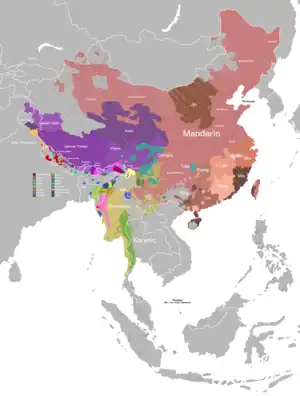| Mara | |
|---|---|
| Mara (Tlosaih) | |
| Pronunciation | [m̥ara] |
| Native to | Mizoram, India; Burma |
| Ethnicity | Mara people |
Native speakers | (ca. 400,000 cited 1994–2011)[1] |
| Latin | |
| Language codes | |
| ISO 639-3 | mrh |
| Glottolog | mara1382 |
| ELP | Mara Chin |
Mara is a Kuki-Chin language spoken by Mara people.
Phonology
Consonants
| Labial | Dental/ Alveolar |
(Alveolo-) palatal |
Velar | Glottal | ||
|---|---|---|---|---|---|---|
| Plosive/ Affricate |
voiceless | p | t | tɕ | k | (ʔ) |
| aspirated | pʰ | tʰ | tɕʰ | kʰ | ||
| voiced | b | d | dʑ | |||
| Fricative | voiceless | f | s | h | ||
| voiced | v | z | ||||
| Nasal | plain | m | n | ŋ | ||
| murmured | mʰ | nʰ | ||||
| Trill | voiced | r | ||||
| voiceless | r̥ | |||||
| Lateral | voiced | l | ||||
| voiceless | l̥ | |||||
| Approximant | w | ɹ̥ | j | |||
- A glottal stop [ʔ] may occur in onsets as a result of morphological combinations.
- /t/ can be dental as [t̪] before /ɑ/ or /i/.
- /k/ can also be heard as uvular [q] before /ɑ/ or /i/.
- /s, z/ when preceding /i/ can be heard as alveolo-palatal [ɕ, ʑ].
- Pre-aspiration can also be heard among nasals as [ʱm, ʱn].[2]
Vowels
| Front | Central | Back | ||
|---|---|---|---|---|
| Close | i | y | ɨ | u |
| i̞ | u̞ | |||
| Mid | e | ø | o | |
| Open | ɑ̝ | |||
| ɑ | ||||
- Sounds /o/ and /ɑ̝/ can be heard in free variation as [ɔ, ɐʊ] and [ʌ].[2]
References
- ↑ Mara at Ethnologue (18th ed., 2015) (subscription required)
- 1 2 Arden, Michelle J. (2010). A phonetic, phonological, and morphosyntactic analysis of the Mara language. San Jose State University.
External links
- Maraland: The Home of the Maras on the internet
- A grammar and dictionary of the Lakher language, by Fred W. Savidge (1908) (Scanned at Internet Archive)
This article is issued from Wikipedia. The text is licensed under Creative Commons - Attribution - Sharealike. Additional terms may apply for the media files.
